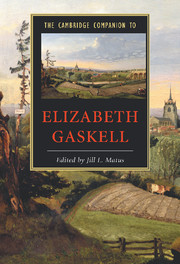Book contents
- Frontmatter
- 1 Introduction
- 2 The life and letters of E. C. Gaskell
- 3 Mary Barton and North and South
- 4 Cranford and Ruth
- 5 Elizabeth Gaskell’s The Life of Charlotte Brontë
- 6 Sylvia’s Lovers and other historical fiction
- 7 Cousin Phillis, Wives and Daughters, and modernity
- 8 Elizabeth Gaskell’s shorter pieces
- 9 Gaskell, gender, and the family
- 10 Elizabeth Gaskell and social transformation
- 11 Unitarian dissent
- 12 Gaskell then and now
- Guide to further reading
- Index
- Series List
7 - Cousin Phillis, Wives and Daughters, and modernity
Published online by Cambridge University Press: 28 May 2007
- Frontmatter
- 1 Introduction
- 2 The life and letters of E. C. Gaskell
- 3 Mary Barton and North and South
- 4 Cranford and Ruth
- 5 Elizabeth Gaskell’s The Life of Charlotte Brontë
- 6 Sylvia’s Lovers and other historical fiction
- 7 Cousin Phillis, Wives and Daughters, and modernity
- 8 Elizabeth Gaskell’s shorter pieces
- 9 Gaskell, gender, and the family
- 10 Elizabeth Gaskell and social transformation
- 11 Unitarian dissent
- 12 Gaskell then and now
- Guide to further reading
- Index
- Series List
Summary
In 1906 A.W. Ward pronounced Cousin Phillis, first serialized in the Cornhill Magazine from November 1863 to February 1864, ''one of the loveliest prose idylls in our literature'' (W, VII, xiv); in 1977 John Lucas questioned the pastoralism of Cousin Phillis but deemed Cranford (1853) and Wives and Daughters, serialized in the Cornhill from August 1864 to January 1866, ''beautiful idylls.'' Pastoral idyll unquestionably forms an element of both Cornhill serials. Paul Manning, the young engineer who narrates Cousin Phillis, emphasizes the quietude of Hope Farm, where time passes so slowly that individual seconds can be marked: ''The tranquil monotony of that hour made me feel as if I had lived for ever . . . with my two quiet hearers, and the curled-up pussy cat sleeping on the hearth-rug, and the clock on the house-stairs perpetually clicking out the passage of the moments'' (CP, II, 242). Part three of Cousin Phillis is structured by the timeless cycles of rural life and the ''little pictures'' (as the Greek eidyllion is often translated) intrinsic to idyll: ''several little scenes, [come] back upon me . . . like pictures to my memory . . . corn harvest must have come after hay-making, apple-gathering after corn-harvest'' (CP, III, 267). Wives and Daughters begins in the suspended time of childhood and nursery rhymes (''To begin with the old rigmarole of childhood. In a country there was a shire''), as twelve-year-old Molly Gibson awakens in wonder at the new attire she will don to visit The Towers, home to Lord and Lady Cumnor (WD, 1:1). In the pages that Gaskell completed before her death abruptly terminated the novel's measured pace, Molly traverses a circuit that encompasses only her village, The Towers, Hamley Hall, Ashcombe, and the fields between.
- Type
- Chapter
- Information
- The Cambridge Companion to Elizabeth Gaskell , pp. 90 - 107Publisher: Cambridge University PressPrint publication year: 2007
- 20
- Cited by

